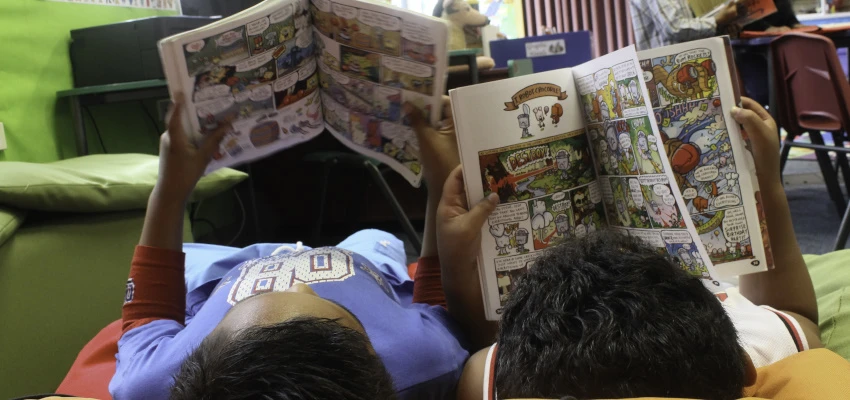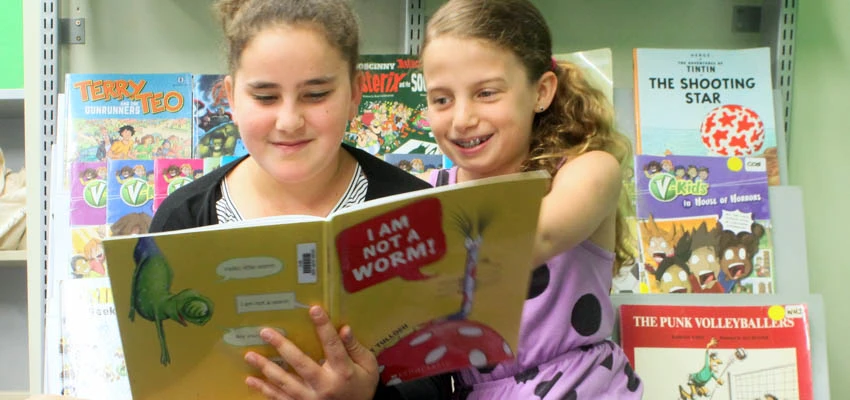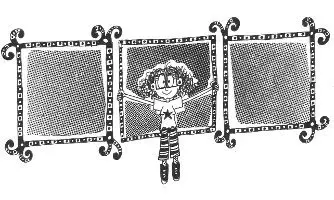Graphic novels

Image credit: All rights reserved.
Graphic novels are a long-form type of comic. Find out how to use them to engage readers and develop visual literacy skills.
What are graphic novels
Published in book format, graphic novels can be fiction or non-fiction and, usually, tell a stand-alone story with a complex plot using illustrations. Graphic novels like Watchmen bring together an episodic series. Librarians often use 'graphic novel' to denote any collected work — whether it be serialised comics collected into one book or long-form works.
The term 'graphic novel' was coined by Will Eisner to distinguish his book A Contract with God (1978) from collections of newspaper comic strips. He described graphic novels as consisting of 'sequential art' — a series of illustrations which, when viewed in order, tell a story. Will Eisner is seen as the founder of graphic novels, and the industry award is named in his honour.
In her Create Readers blog post '"Graphic novels"' is not comics’, comic creator Indira Neville writes:
The most important thing to say up front is that while all graphic novels are comics, not all comics are graphic novels. Graphic novels are a particular type of comic. It goes like this …
Comics is the medium (like ‘poetry’ or ‘film’ is a medium).
A comic is any work in the comics medium regardless of genre, length, or format (like ‘a poem’ or ‘a film’).
A graphic novel is a long-form work of fiction in the comics medium (like an ‘ode’ or a ‘feature film’).
— 'Graphic novels' is not comics
Manga
Manga, or 'whimsical drawings' (literal translation), are Japanese comics, read in the reverse order from English books. Manga is often in black and white, and published as a series in magazines or volumes with genres ranging from romance to science fiction.
Manga differs from American-style graphic novels in the storytelling techniques it applies (such as wordless panels) and in the subject matter. Each book is closely targeted at a specific demographic.
Publishers Viz and TokyoPop have translated a broad number of Manga titles into English.
The appeal of art and story to engage readers
Graphic novels have always been popular with students — from English for speakers of other languages (ESOL) students and reluctant readers to avid readers.
Combining visual art with literary and cinematic techniques allows for innovative and stimulating storylines. Graphic novels promote oral and visual literacy, as well as a love for reading. The wide range of available genres guarantees their popularity and usage in any library.
Graphic novels can be used to transition younger readers into novels, with popular series such as Geronimo Stilton and Tinkerbell publishing graphic novel formats. Their non-threatening presentation of text and illustrations also appeal to more reluctant readers.
How to read a graphic novel
Graphic novels are an invaluable resource for teaching visual literacy skills and ideal for teens, as discussed in 'The truth about graphic novels' by Kristin Fletcher-Spear, Merideth Jenson-Benjamin, and Teresa Copeland.
The truth about graphic novels: A format, not a genre
Their compelling artwork and innovative design mean readers can also focus on:
the interplay of the words and graphics on each page
the layout arrangement (placement and size) of the panels
details that illuminate the characters
how narration and dialogue are arranged.
Scholastic has written a guide for using graphic novels with children and teens, which includes a link to a further guide for teaching graphic novels.
Graphic novels don’t work exactly the same way that traditional novels do, but they can be as demanding, creative, intelligent, compelling, and full of story as any book.
— Robin Brenner
No Flying, No Tights — created by Robin Brenner, this is a great resource of graphic novels and reviews for all ages.
Graphic novels in your school library
Develop a range of graphic novels, for example, superheroes, manga, classics, novels, non-fiction. Think about how and where you'll shelve them:
Will you put fiction and non-fiction together?
If you have a separate collection of all your graphic novels, what signage will you use?
If you keep your non-fiction items separate, how will people find them?
Selecting and purchasing resources
Arranging library fiction by genre
Not-to-be-missed graphic novels
Well-known series such as Tintin and Asterix are essential additions to any collection. DC and Marvel comics, the two biggest mainstream American comics publishers, are well known to many for being home to the ‘world’s greatest superheroes’. They have also produced kid-friendly imprints, such as DC Graphic Novels for Kids. Aimed at intermediate-level 8- to 12-year-olds, DC Graphic Novels for Kids publishes familiar authors such as:
Meg Cabot writing Black Canary Ignite about Gotham City teenager Dinah Lance
Ridley Pearson, who wrote Super Sons about the sons of Batman and Superman
Sholly Fisch who writes characters like Batman and Teen Titans.
DC is aimed at young adults aged 13 plus. It includes new stories about Wonder Woman, Teen Titans Raven and Harley Quinn by well-known YA authors such as:
Mariko Tamaki (This One Summer)
Leigh Bardugo (Six of Crows)
Kami Garcia (Beautiful Creatures).
Marvel has ‘rising readers’, a series of graphic novel compilations curated from Marvel's vast library targeted at intermediate readers. It also has ‘vault of heroes’, a similar set of graphic novels for primary readers upwards. Students will love the action and humour, and the great diverse range of heroes, such as Unbeatable Squirrel Girl, Black Panther, Ms. Marvel, and the big names like Spiderman, Thor and Hulk.
A few graphic novels and authors to look out for include:
Neil Gaiman who is renowned as an international leader in this field and writes for children up to adults
Rania Telgemeier and Ann M. Martin's adaptation of The Babysitter's Club series
Alice Oseman, author of Heartstopper, one of several comic creators who started with a webcomic, which was then published in print.
Download our Book and Beyond guide for exploring 'Heartstopper'
From New Zealand
Hicksville by Dylan Horrocks (YA).
Ant Sang who has created several popular comics, including Go-Go Ninjas — a YA fiction finalist in the 2019 New Zealand Book Awards for Children and Young Adults.
Chris Slane's Maui series, as well as his artwork for A Nice Day for a War.
Moa by James Davidson.
The Tea Dragon Society is a webcomic for 8- to 12-year-olds that can be read online and is available in print. The author Katie O’Neill is a two-time Eisner Award winner.
Prize-winning graphic novels
A few graphic novels that have won notable awards include the following:
El Deafo by Cece Bell won the John Newbury Medal and the Eisner Award for Best Publication for Kids in 2015 (ages 8 to 12 years).
Illegal by Eoin Colfer and Andrew Donkin won the 2019 Excellence in Graphic Literature Award (YA).
Maus by Art Spiegelman won the Pulitzer Prize Special Citations and Awards in 1992 (YA).
Salt Magic by Hope Larson and Rebecca Mock won the 2022 Eisner Award for Best Publication for Kids ages 9–12.
Asadora! By Naoki Urasawa and The Hazards of Love, Vol. 1: Bright World by Stan Stanley. Both made the top 10 of the 2022 Great Graphic Novels for Teens.
When Stars are Scattered by Victoria Jamieson and Omar Mohamed. The novel has been nominated for many awards and won the 2021 Walter Dean Myers Award for Younger Readers. It was also included in the selection for the ILA Notable Books for a Global Society in 2021.
The Best We Could Do by Thi Bui is a memoir set in the years before, during, and after the Vietnam War, which won the 2018 American Book Award for illustrated memoir (YA).
This One Summer by Mariko Tamaki and Jillian Tamaki won the 2015 Eisner Award for Best New Graphic Novel, the 2014 Ignatz Award for Outstanding Graphic Novel, and a Printz Honor and a Caldecott Honor in 2015 (YA).
The Vision: The Complete Collection by Tom King and Gabriel Hernandez Walta (Marvel Comics), won an Eisner Award for Best Limited Series (YA).
Organisations, events and awards celebrating reading
Review sites and where to buy graphic novels
Use our Books and Reads tool to find websites that review graphic novels.
Book awards: Booklist's top 10 graphic novels for youth — LibraryThing — recommendations for graphic novels with lists put out by the American Library Association (ALA), 'School Library Journal', and others.
Christchurch City Library’s graphic novel reading guide — includes a manga guide and booklists.
NPR's 100 favourite comics and graphic novels — a great round-up of favourites for all ages, which they selected from more than 7,000 nominations.
Where to buy graphic novels in New Zealand
Specialist suppliers of graphic novels in New Zealand are:
Arkham City Comics — 2/885 Manukau Road, Royal Oak, Auckland, phone +64 9 625 6537
Graphic — 105 Cuba Mall, Wellington, phone +64 4 384 2691
Heroes for sale — Level 1, 3–9 Railway St, Newmarket, Auckland, phone +64 9 378 8414.
Find out more
Comics in Education — a comic site for parents, teachers and librarians.
Get graphic — resources for teachers and librarians including an extensive list of resources and suppliers for collection development.
Graphic Novels 101 — Anastasia Betts provides information and resources for educators.
New Zealand Comics and Graphic Novels — Hicksville Press — New Zealand comics and graphic novels, a 100-page directory of New Zealand cartoonists and comic creators as a free download.
Reading lessons: Graphic novels 101 — by Hollis Margaret Rudiger.
The Center for Cartoon Studies — includes lesson plans, exercises, study guides and sample scripts.
Related content

Tween readers — keeping them motivated
Keeping children reading during the tween years, from around ages 9 to 12, can be a challenge. Knowing their interests and providing a range of reading material will help keep their enjoyment of reading alive.